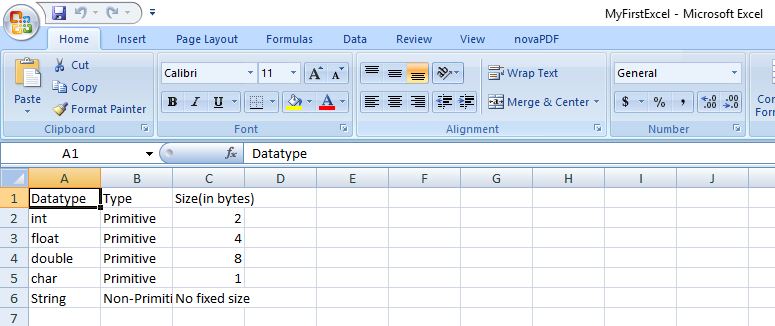Apache POI – Reading and Writing Excel file in Java
来源于:https://www.mkyong.com/java/apache-poi-reading-and-writing-excel-file-in-java/
In this article, we will discuss about how to read and write an excel file using Apache POI
1. Basic definitions for Apache POI library
This section briefly describe about basic classes used during Excel Read and Write.
HSSFis prefixed before the class name to indicate operations related to a Microsoft Excel 2003 file.XSSFis prefixed before the class name to indicate operations related to a Microsoft Excel 2007 file or later.XSSFWorkbookandHSSFWorkbookare classes which act as an Excel WorkbookHSSFSheetandXSSFSheetare classes which act as an Excel WorksheetRowdefines an Excel rowCelldefines an Excel cell addressed in reference to a row.
2. Download Apache POI
Apache POI library is easily available using Maven Dependencies.
<dependency>
<groupId>org.apache.poi</groupId>
<artifactId>poi-ooxml</artifactId>
<version>3.15</version>
</dependency>3. Apache POI library – Writing a Simple Excel
The below code shows how to write a simple Excel file using Apache POI libraries. The code uses a 2 dimensional data array to hold the data. The data is written to a XSSFWorkbook object. XSSFSheet is the work sheet being worked on. The code is as shown below:
package com.mkyong;
import org.apache.poi.ss.usermodel.Cell;
import org.apache.poi.ss.usermodel.Row;
import org.apache.poi.xssf.usermodel.XSSFSheet;
import org.apache.poi.xssf.usermodel.XSSFWorkbook;
import java.io.FileNotFoundException;
import java.io.FileOutputStream;
import java.io.IOException;
public class ApachePOIExcelWrite {
private static final String FILE_NAME = "/tmp/MyFirstExcel.xlsx";
public static void main(String[] args) {
XSSFWorkbook workbook = new XSSFWorkbook();
XSSFSheet sheet = workbook.createSheet("Datatypes in Java");
Object[][] datatypes = {
{"Datatype", "Type", "Size(in bytes)"},
{"int", "Primitive", 2},
{"float", "Primitive", 4},
{"double", "Primitive", 8},
{"char", "Primitive", 1},
{"String", "Non-Primitive", "No fixed size"}
};
int rowNum = 0;
System.out.println("Creating excel");
for (Object[] datatype : datatypes) {
Row row = sheet.createRow(rowNum++);
int colNum = 0;
for (Object field : datatype) {
Cell cell = row.createCell(colNum++);
if (field instanceof String) {
cell.setCellValue((String) field);
} else if (field instanceof Integer) {
cell.setCellValue((Integer) field);
}
}
}
try {
FileOutputStream outputStream = new FileOutputStream(FILE_NAME);
workbook.write(outputStream);
workbook.close();
} catch (FileNotFoundException e) {
e.printStackTrace();
} catch (IOException e) {
e.printStackTrace();
}
System.out.println("Done");
}
}On executing the above code, you get below excel as an output.

4. Apache POI library – Reading an Excel file
The below code explains how to read an Excel file using Apache POI libraries. The function getCellTypeEnum is deprecated in version 3.15 and will be renamed to getCellType from version 4.0 onwards.
package com.mkyong;
import org.apache.poi.ss.usermodel.*;
import org.apache.poi.xssf.usermodel.XSSFWorkbook;
import java.io.File;
import java.io.FileInputStream;
import java.io.FileNotFoundException;
import java.io.IOException;
import java.util.Iterator;
public class ApachePOIExcelRead {
private static final String FILE_NAME = "/tmp/MyFirstExcel.xlsx";
public static void main(String[] args) {
try {
FileInputStream excelFile = new FileInputStream(new File(FILE_NAME));
Workbook workbook = new XSSFWorkbook(excelFile);
Sheet datatypeSheet = workbook.getSheetAt(0);
Iterator<Row> iterator = datatypeSheet.iterator();
while (iterator.hasNext()) {
Row currentRow = iterator.next();
Iterator<Cell> cellIterator = currentRow.iterator();
while (cellIterator.hasNext()) {
Cell currentCell = cellIterator.next();
//getCellTypeEnum shown as deprecated for version 3.15
//getCellTypeEnum ill be renamed to getCellType starting from version 4.0
if (currentCell.getCellTypeEnum() == CellType.STRING) {
System.out.print(currentCell.getStringCellValue() + "--");
} else if (currentCell.getCellTypeEnum() == CellType.NUMERIC) {
System.out.print(currentCell.getNumericCellValue() + "--");
}
}
System.out.println();
}
} catch (FileNotFoundException e) {
e.printStackTrace();
} catch (IOException e) {
e.printStackTrace();
}
}
}On executing the above code, you get the below output.
Datatype--Type--Size(in bytes)--
int--Primitive--2.0--
float--Primitive--4.0--
double--Primitive--8.0--
char--Primitive--1.0--
String--Non-Primitive--No fixed size--References
- Details about deprecation of getCellTypeEnum
- Apache POI reference regarding Deprecation
- Apache POI Maven Repo
- Apache POI API docs
最新文章
- react-redux原理分析
- iOS 运行时
- oracle数据库使用三个月的总结
- Boostrap(2)
- iOS设备通知中心精品推荐消息删除
- 配置ORACLE 客户端连接到数据库
- 新闻客户端nices
- error: Error: No resource found that matches the given name (at 'layout_above' with value '@id/btnLayout').
- 在打包程序中自动安装SQL Server数据库 .
- Hibernate(四)之对象状态及一级缓存
- Yourphp是一款完全开源免费的.核心采用了Thinkphp框架
- 一文读懂阻塞、非阻塞、同步、异步IO
- 在xp下无人值守自动安装系统
- (转)App.Config详解及读写操作
- nil
- zabbix_get无法执行agent端的脚本文件解决办法
- Field Security Profile Helper
- link和@import的区别是什么 ?
- CSS浮动为什么不会遮盖同级元素
- define用于条件编译